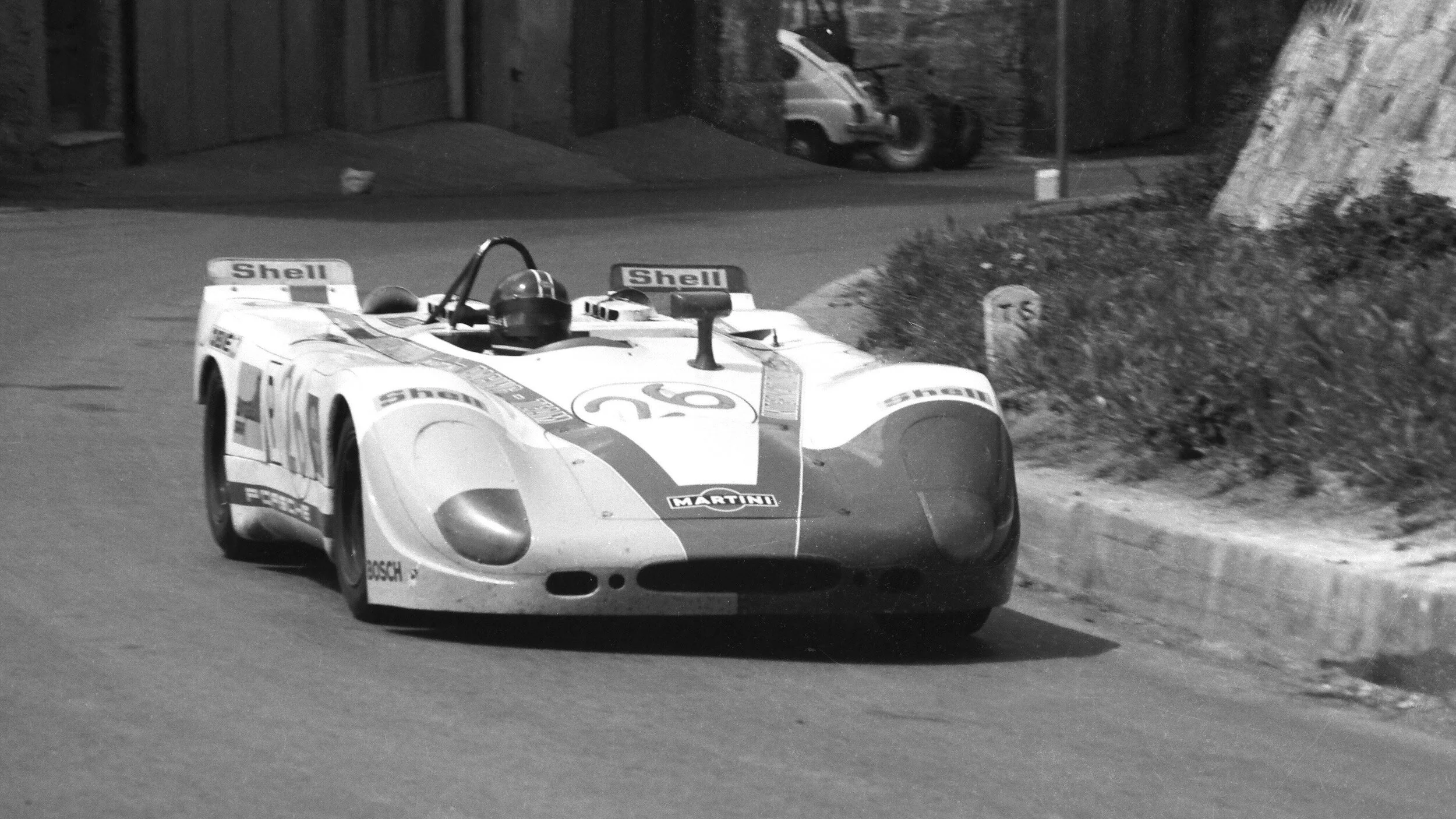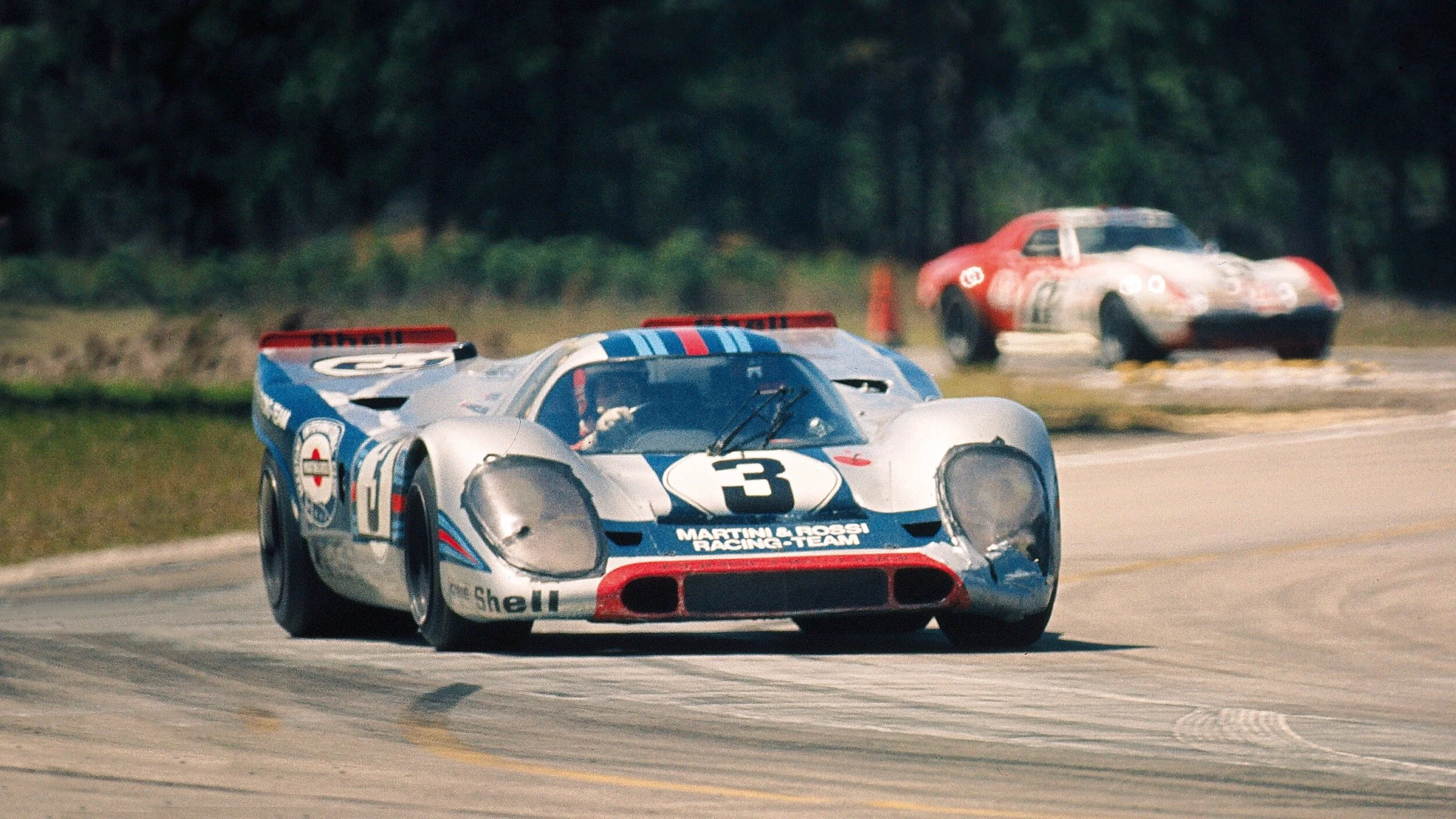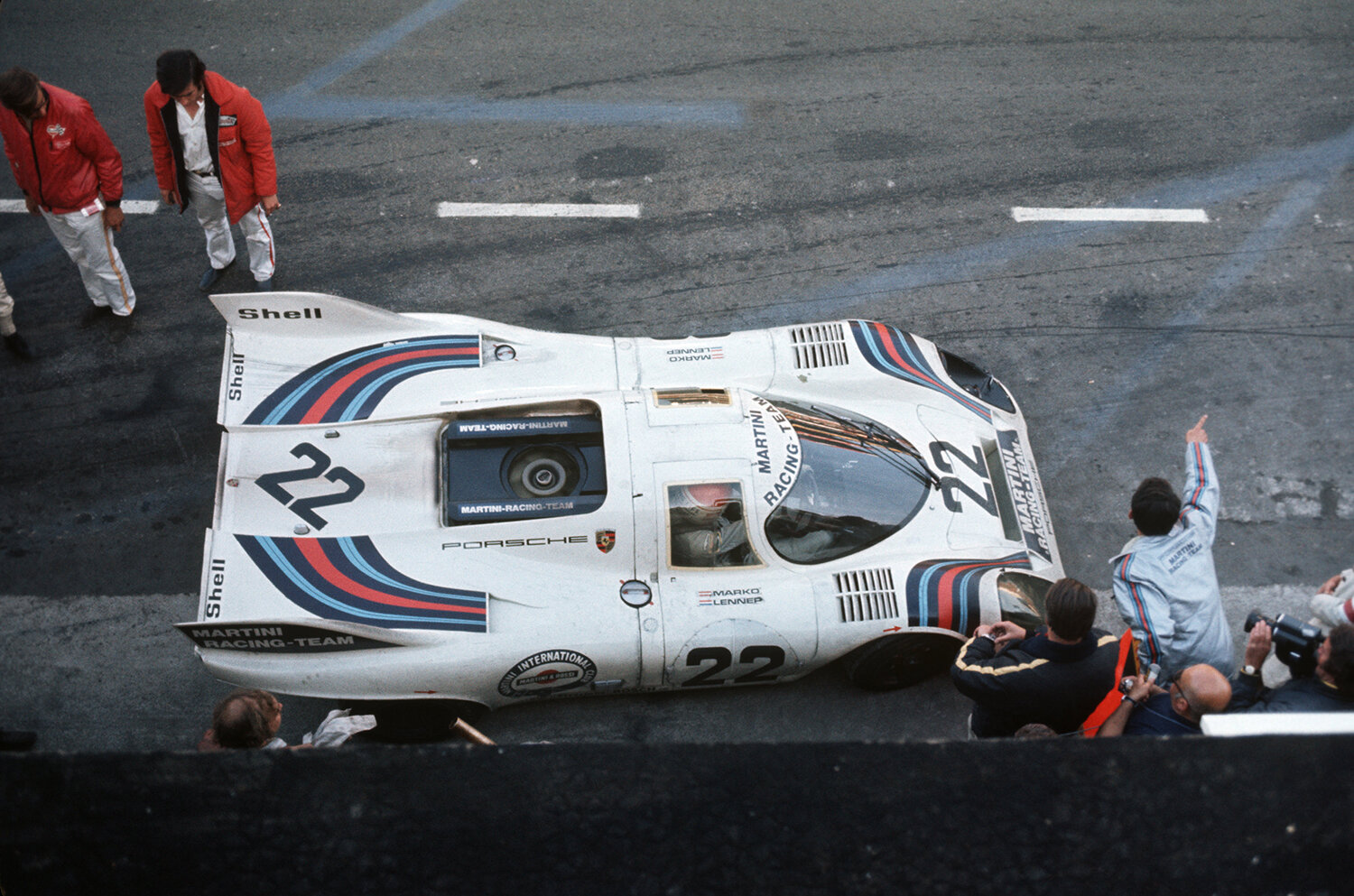Martini’s Road to Le Mans victory
Many Porsche race cars are remembered not only for plentiful success, but also for instantly recognisable colour schemes led by various commercial partnerships. Nothing livened the flanks of a Porsche 935 like the mint green bodywork and multi-coloured stripes of the Vaillant boiler company. Derek Bell instilled a thirst for Lowenbrau with the dominant 962 painted in the navy blue and white of the German brewery. Even the bright yellow and red of the DHL logistics firm ensured Roger Penske’s Porsche RS Spyders stood out on track.
Arguably, the most memorable colours to grace the race cars of Weissach, are those of Martini and Rossi. Across a wonderful decade, the relationship between the family run Italian vermouth firm and Porsche blossomed from a regional handshake agreement to a formidable racing alliance.
Since the 1950s, Martini’s simple yet distinctive logo could be found on trackside billboards at various racing venues round the world. In fact, Martini supported the fledgling Sebring International Raceway by donating a footbridge for spectators to cross the circuit. However, the support of individual teams or drivers was still an unfamiliar concept to the Italian company.
Director for PR and Publicity at Martini Germany, Paul Goppert, was the man who began Martini’s racing legacy as we know it today. To begin with, Goppert engaged in some typical national motorsport horse trading. Plucky independent drivers would display Martini stickers on their machines in return for jackets, pens, and other promotional items.
German Porsche racer, Hans Dieter Dechent, was the first to extract hard cash from Martini Germany’s purse. To begin with, a paltry sum of 5000DM was granted to Dechent’s independent operation and Martini logos would be liberally distributed over the team’s cars. On debut, Dechent’s Martini branded Porsche 906 took victory in the 2-litre class at the 1968 Nurburgring 1000km with Reinhold Joest and Erich Bitter behind the wheel. Joest would eventually play a notorious part in Martini and Porsche folklore.
For 1969, Martini’s support of Dechent’s ‘German B.G’ team trebled to 15,000DM. However, success eluded the privateer squad and four Porsche prototypes were destroyed over the season. Nevertheless, a sticky situation at the 1969 Nuremberg 200 miles at the Norisring presented an ideal opportunity for Dechent to deploy some mischievous privateer ingenuity. On arrival to scrutineering, German B.G’s Porsches sparked a row. Or more specifically, their Martini branding. With the race due to be televised, race organisers demanded that Dechent remove the Martini stickers or be excluded from competition. Dechent argued his case that his team would be severely out of pocket if forced to remove their sponsor’s logo.
Eventually, a compromise was agreed where Dechent covered only the ‘Martini’ lettering (thus retaining the unmistakeable logo) and be paid handsomely for his co-operation. However, the devious Dechent had another trick up his sleeve. Prior to the race, Dechent hopped up to the commentary booth and bribed the circuit announcer to continually remind fans that his team’s car had been entered by Martini!
During a press conference at Hockenheim at the end of 1969, Porsche management announced who would represent the Wuttemberg coat of arms in the 1970 season. Confirmation of John Wyer’s Gulf-Porsche and Louise Piech’s Porsche Salzburg team came as little surprise. However, the addition of the ‘German Racing Team’ may have raised eyebrows in certain quarters.
Alongside a white, red, and yellow colour scheme, the German Racing Team cars wore a chrome silver V shaped stripe. Furthermore, the team’s Porsche 908s proudly displayed the moniker of the ‘Martini International Racing Team’.
With Porsche now behind the Martini backed outfit, the hallowed ground of Le Mans lay ahead. In March 1970, Dechent requested three entries to the 24-hour classic. However, only one would be granted by the ACO overlords. Once again, the crafty Dechent deployed a trademark ruse.
Expressing his disappointment with his solitary entry, Dechent revealed an initially fictional wish to have a Frenchman drive in a Porsche 917. Instantly, the ACO increased the German Racing Team’s entry to three cars. With entries now in hand, Dechent set to work on finding a Porsche 917 and a Frenchman to drive it! Luckily for Dechent, Porsche had a glut of 917s and a shortage of grid slots for Le Mans.
Now known as the ‘Martini International Racing Team’, Dechent’s team arrived to Le Mans in 1970 with their trusty Porsche 908s and the revolutionary Porsche 917 long tail. As promised, Frenchman Gerard Larrousse would drive Martini’s 917 alongside German, Willi Kauhsen.
Amongst a gang of Porsche 917s, Ferrari 512s and factory Matras, Dechent ensured that his leading machine stood out in this first-class field. A wonderfully wacky purple and white voodoo design was chosen for the streamlined 917, much to the annoyance of Martini’s owner, Count Gregorio Rossi. Still craving an even more lurid palette, Dechent’s crew spent the night before the race filling in the white sections of the 917’s bodywork with green spray paint!
Disruptive paint work aside, the Martini Racing Team’s first Le Mans in 1970 was a resounding success. Second place for Larrousse and Kauhsen’s psychedelic 917 and third for Helmut Marko and Rudi Lins’ 908 marked a dream debut for the German-Italian alliance. Despite the success, Count Gregorio Rossi failed to be convinced on the purple and green colours.
At the end of 1970, another twist of fate played in Martini’s favour. Perhaps due to the displeasure of John Wyer, who believed his Gulf team would be the standalone works outfit, the Porsche Salzburg team that claimed Porsche’s first Le Mans win was disbanded. Controlling costs was the public party line. However, the feud between Wyer and Porsche’s frontman Ferdinand Piech was difficult to conceal.
Martini needed no second invitation to fill the place of the disbanded Porsche Salzburg team. Taking on Salzburg’s three Porsche 917s and equipment, the Martini-Rossi racing team effectively moved into Porsche’s workshop in Weissach where the cars would be built and prepared.
Conversely, the fiercely independent John Wyer insisted on running his Gulf-Porsche operation from the J.W Engineering base in Slough. Wyer would have access to Porsche assistance if he wished and if his pride allowed. Martini’s operational advantage of working on site in the Porsche workshops with works mechanics, proved pivotal to on track success and a long-standing relationship.
Now boasting the equipment and infrastructure to succeed at the highest level, Martini aimed for the top. On the 27th of December 1970, Count Gregorio Rossi and brother Vittorio announced to gathered media at Hockenheim of their intention to reach the top of world championship racing.
At the press conference, the now iconic Martini racing colours were revealed for the first time. Draped across an immaculate silver Porsche 917, the soon to be instantly recognisable navy blue and red stripes looked purposeful and elegant in equal measure.
By March 1971, the Martini-Rossi racing team scored their first World Championship triumph. At the brutal 12 hours of Sebring, Vic Elford and Gerard Larrousse survived an early clash with a slower car to win the blue riband event. After vanquishing the factory Alfa Romeos, a Penske Ferrari and the Gulf Porsches, the Martini-Rossi racing team had arrived at the top table.
Martini-Rossi racing team entered the 1971 24 hours of Le Mans in fine form. By now, the Porsche 917 had reached the peak of its development curve and Martini enjoyed the use of three different 917 iterations for the day long classic.
Sebring winners, Elford and Larrousse, piloted the long-tailed #21 machine painted in chrome silver and mandatory Martini stripes. Helmut Marko and Gijs van Lennep were entrusted with the experimental magnesium chassis #22 car, painted white rather than silver.
Willi Kauhsen and Reinhold Joest took the reins of the black sheep of the Martini racing trio. Or, more accurately, the Pink Pig. Throughout the life of the 917, Porsche’s engineers tinkered constantly with the recipe. Dubbed ‘917/20’, this latest iteration of Porsche’s Le Mans winner had a wider chassis than the rest of the 917 family. The result was a car deemed to resemble a pig. To poke fun at the runt of the 917 litter, Porsche painted the car pink with fictional butcher’s cuts marked across the bodywork. Thus, ‘The Pink Pig’ was born. Unfortunately, the German sense of humour was lost on the irate Count Gregorio Rossi who refused to acknowledge the poor Pink Pig as a Martini entered car.
Sense of humour failure aside, the 1971 Le Mans 24 hour would be a landmark year for the Martini-Rossi racing team. Marko and van Lennep negotiated 24 hours with aplomb and charged to victory in the #22 Martini Porsche. So perfect was Marko and van Lennep’s race, that their distance record stood until 2010.
For most of the 1970s, Porsche and Martini’s alliance continued to blossom and yield bountiful success. Despite the relationship drawing to a natural conclusion in 1979, an immortal die had been cast for Martini. Those instantly recognisable stripes live on in the finest bars around the world and in the hearts of Porsche fans. Grazie mille, Martini.

















